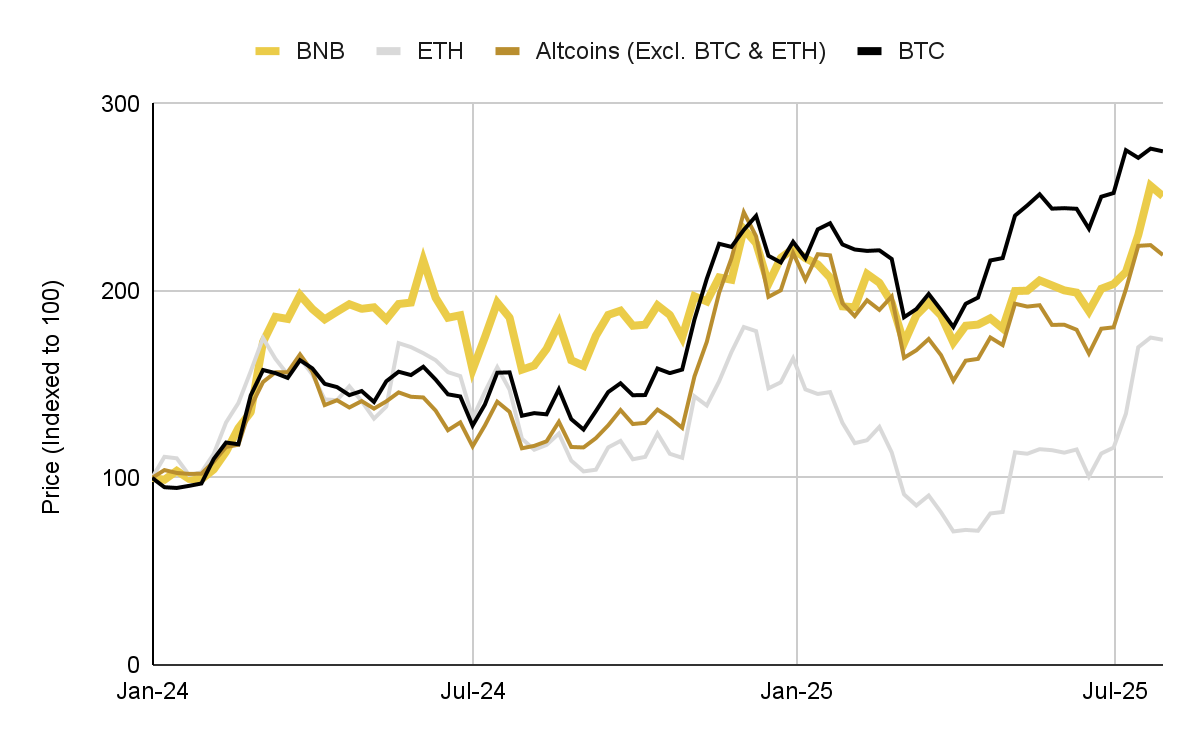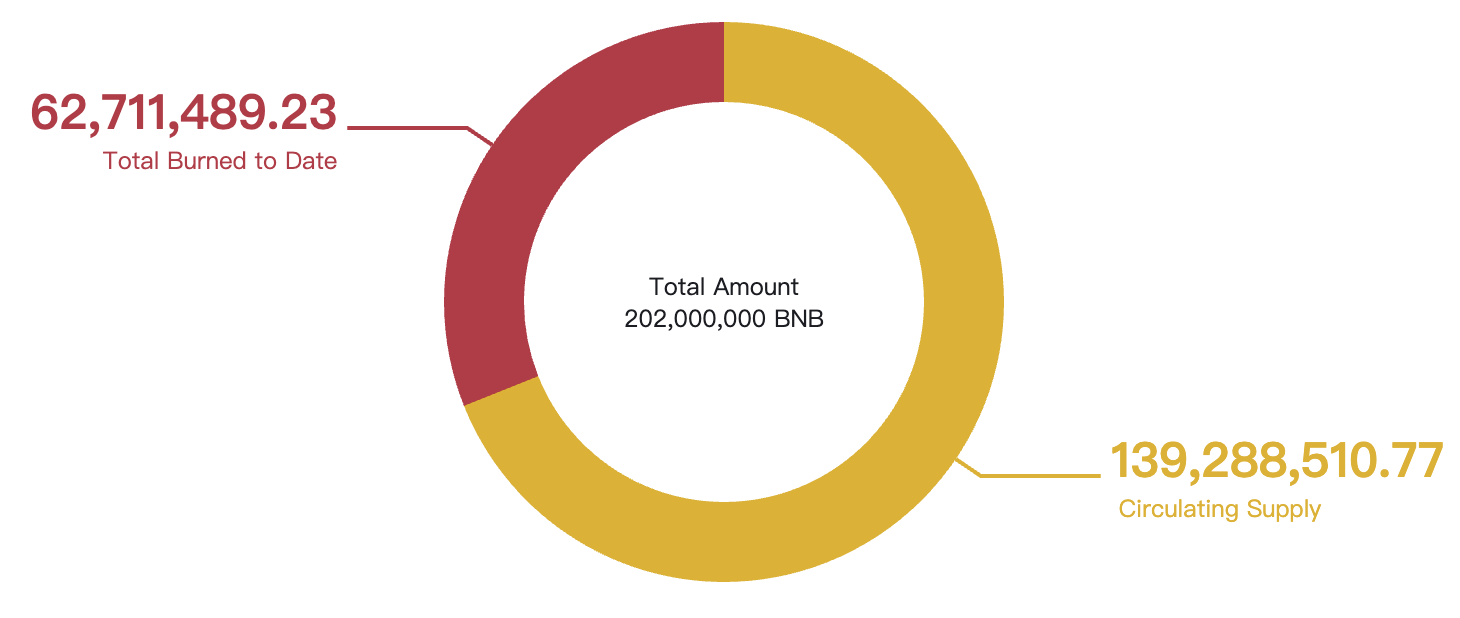BNB has recently broken past US$850 to a new all-time high, cementing its position as the world’s third largest altcoin by market cap.
Its sustained growth is backed by strong risk-adjusted returns, spot-driven rallies, and rising corporate treasury adoption.
These structural drivers, combined with BNB’s real-world and ecosystem utility, reinforce its long-term value beyond speculation.
Earlier this week, BNB smashed through the $850 mark – setting a brand-new all-time high by leaving its previous $800 record behind. With this surge, BNB’s market cap soared to $119B, cementing its spot as the world’s third-largest altcoin (excluding stablecoins). This blog dives into the key structural drivers behind BNB’s sustained growth, including its impressive risk-adjusted returns, spot-driven rallies, and increasing adoption by corporate treasuries. We also explore BNB’s expanding real-world utility within the BNB Chain ecosystem, as well as the strategic roadmap that positions BNB for long-term success.

BNB’s breakout sets it apart from the rest of the market. Among the top 100 cryptocurrencies by market capitalization (excluding tokens less than two years old), BNB is the only major asset besides BTC to hit a fresh all-time high this month. This matters because many long-standing tokens – even in strong bull markets – often struggle to reclaim their previous peaks, let alone set new ones.
The fact that BNB broke through and sustained a powerful five-week rally highlights growing market confidence. It shows that investors increasingly perceive BNB as a blue-chip asset – one with staying power, solid fundamentals, and resilience.
As a result, BNB is now the third-largest altcoin by market capitalization, trailing only ether (ETH) and Ripple’s XRP. This milestone underscores BNB’s growing prominence in the market, cementing its position as a core asset for investors seeking crypto exposure beyond bitcoin.
Source: Coinmarketcap, Binance Research, as of July 23, 2025
BNB has also emerged as a standout performer when it comes to balancing returns with risk. Over the past five years, its Sharpe ratio – a metric that gauges how much return an asset delivers relative to the risk taken – reached 2.5. In simpler terms, for every dollar of risk, BNB generated $2.50 in returns. This puts BNB ahead of traditional market indices and other large-cap cryptocurrencies, signaling not just strong performance but also a comparatively stable risk profile over time.

BNB’s latest rally appears to be built on a healthy foundation. At the time of its recent all-time high, BNB futures open interest – a measure of capital committed to futures contracts – was less than 60% of its previous peak.
This lower level of leveraged activity suggests the surge wasn’t driven by speculative trading. In past market cycles, rallies with futures open interest near record highs often signaled overheated, unstable conditions, as traders relied heavily on borrowed funds to chase momentum. In contrast, the current rally is supported by new capital flowing into the spot market, with investors taking longer-term positions. This points to genuine conviction rather than an unsustainable rally at risk of unwinding due to fleeting leveraged bets.
Following in bitcoin’s footsteps, a new wave of “BNB treasury” strategies is taking shape among publicly traded companies. Some firms are issuing convertible bonds, while others are directly purchasing BNB, using it as a reserve asset to boost treasury returns, enhance liquidity, and gain strategic exposure to the broader crypto ecosystem.
At least 30 corporate teams are currently exploring this approach, with several having already made public disclosures. Below are some of the most notable examples publicly shared to date.
Source: Yahoo Finance, Blockbeats, Binance Research, as of July 28, 2025
These developments signal BNB’s evolution from a primarily retail-driven asset into one with growing institutional recognition. Even with only a handful of public plans disclosed, the combined potential buying pressure already exceeds $1.8 billion – a figure that represents strong market recognition.
To put the numbers into perspective, public company treasuries currently hold about $3.7 billion in ether (ETH), which represents just 0.83% of ETH’s total market capitalization. In comparison, a $1.8 billion reserve allocation to BNB would already account for over 1.5% of its supply – giving BNB a higher proportion of corporate recognition relative to its market size than ETH.
The long-term impact of this trend could be profound. Beyond enhancing BNB’s legitimacy as an institutional-grade reserve asset, this trend introduces a steady, structural source of demand that is less dependent on retail sentiment or short-term trading cycles. With corporate treasuries likely to hold for the long term, this could help establish a “demand floor” for BNB’s price and contribute to reduced volatility over time – further cementing BNB’s role alongside BTC as an institutional-grade reserve digital asset.
BNB’s value is not merely speculative. It is supported by a self-reinforcing “utility flywheel” – a continuous cycle where real-world and ecosystem-wide utility drives demand, which strengthens the asset’s value and fuels further development across both centralized and decentralized ecosystems.
Within the Binance ecosystem, BNB plays a pivotal role in driving user engagement and demand. Holders gain tangible economic benefits such as trading fee discounts, while exclusive participation in token sales via Binance Launchpad and new token farming opportunities on Launchpool act as continuous demand sinks, locking up supply. Binance also offers a range of yield-bearing financial products, enabling users to stake BNB and earn rewards – further deepening engagement and utility.
But BNB’s role isn’t limited to trading or staking within the Binance platform. Its utility now extends into everyday life through Binance Pay, where users can spend BNB to purchase goods and services worldwide, from retail products to dining and entertainment. Travelers can also use BNB to book hotels, flights, and experiences through partners like Travala.com. Hence, BNB is also a practical medium of exchange that bridges the gap between digital assets and daily spending.
BNB is the lifeblood of BNB Chain, serving as the native gas token for all network activity. Much like ether (ETH) on Ethereum, BNB powers over 1,300 decentralized applications (DApps) and acts as a core liquidity and collateral asset across the network’s thriving DeFi landscape. Whether it’s paying transaction fees on the BNB Smart Chain (BSC), interacting with the opBNB layer-2 (L2) scaling solution, or accessing decentralized storage through Greenfield, BNB fuels every layer of the ecosystem.
BNB Chain goes beyond a single-purpose blockchain by integrating three layers – BSC, opBNB, and Greenfield – into what’s known as the One BNB paradigm. This interconnected framework enables seamless interaction between decentralized computing, scaling, and storage, amplifying the demand and utility of the BNB token compared to tokens on blockchains built around a single function.
Beyond powering transactions and DeFi, BNB also secures the network and gives users a voice in its future. Validators stake BNB to maintain network security and earn rewards, while everyday users can delegate their stake to share in these rewards. Staking also grants governance rights, allowing participants to vote on upgrades and protocol changes – making BNB not just a utility token, but a cornerstone of BNB Chain’s security and evolution.
While many cryptocurrencies continuously issue or unlock new tokens – gradually inflating their circulating supply – BNB takes a different approach. Its Auto-Burn system systematically reduces the total supply of BNB over time, reinforcing its scarcity by countering inflation. Since the mechanism began over seven years ago, 31% of BNB’s original 200 million total supply has been permanently removed from circulation.

BNB Chain’s 2025–2026 technical roadmap seeks to combine the speed and simplicity of centralized exchanges (CEXs) with the freedom and self-custody of decentralized blockchains to create the next high-performance infrastructure for mass adoption.
BNB Chain is working to be much faster and more scalable. By 2026, it aims to handle over 20,000 transactions per second with confirmation times under 150 milliseconds. These upgrades are designed to bring BNB Chain’s performance on par with, or even beyond, traditional financial networks such as Nasdaq, which is a critical step toward supporting large-scale, real-world adoption.
The roadmap also includes an upgradable virtual machine designed to handle heavier workloads – like advanced DeFi platforms and blockchain games. It will also support private transactions, stay compliant with regulations, and help Web3 apps run more smoothly at scale.
BNB Chain is making it easier for developers to build by offering tools, funding, and support through programs like Launch-as-a-Service and the BNB Incubation Alliance. Strategic partnerships, such as with Ondo Finance, will introduce over 100 tokenized US equities, ETFs, and funds – bringing trillion-dollar capital markets on-chain. Upgrades to BNB Greenfield will also support AI apps and unlock new data monetization models, expanding BNB Chain’s role beyond DeFi.
BNB’s surge past the US$850 mark is more than a short-lived rally. From leading risk-adjusted performance over the past five years and sustaining rallies built on real spot demand, to attracting institutional interest as a treasury asset, BNB has proven its ability to grow beyond retail-driven cycles.
Unlike equities, BNB’s trajectory is not directly tied to corporate valuation or profit. Its value is reinforced by utility that spans the Binance ecosystem, the broader BNB Chain, and even real-world commerce. With mechanisms like Auto-Burn supporting long-term scarcity and a forward-looking roadmap designed to rival the speed and simplicity of traditional financial networks, BNB is laying the groundwork to remain a core force in the evolving digital economy. BNB is one to watch as the market continues to mature.